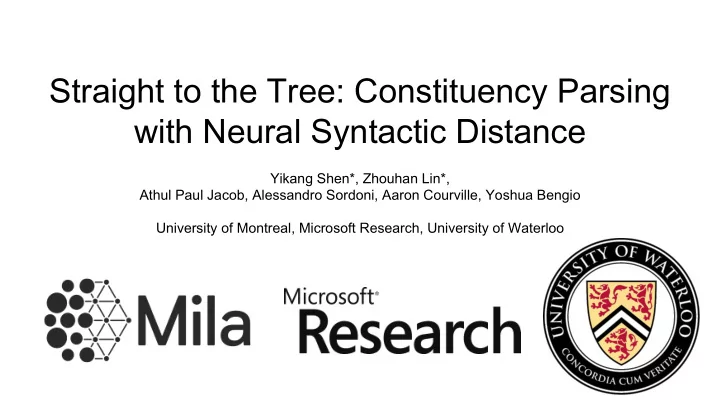

Straight to the Tree: Constituency Parsing with Neural Syntactic Distance Yikang Shen*, Zhouhan Lin*, Athul Paul Jacob, Alessandro Sordoni, Aaron Courville, Yoshua Bengio University of Montreal, Microsoft Research, University of Waterloo
Overview - Motivation - Syntactic Distance based Parsing Framework - Model - Experimental Results
Overview - Motivation - Syntactic Distance based Parsing Framework - Model - Experimental Results
ICLR 2018: Neural Language Modeling by Jointly Learning Syntax and Lexicon Syntactic Structured LSTM Distance Self-Attention Supervised Constituency Parsing with Syntactic Distance? Language Unsupervised Model Constituency parser (61 ppl) (68 UF1) [Shen et al. 2018]
Chart Neural Parsers Transition based Neural Parsers 1. Greedy decoding: 1. High computational cost: Incompleted tree (the shift and Complexity of CYK is O(n^3). reduce steps may not match). 2. Complicated loss function: 2. Exposure bias The model is never exposed to its own mistakes during training [Stern et al., 2017; Cross and Huang, 2016]
Overview - Motivation - Syntactic Distance based Parsing Framework - Model - Experimental Results
Intuitions Only the order of split (or combination) matters for reconstructing the tree. Can we model the order directly?
Syntactic distance N1 N2 For each split point , their syntactic distance should share the same order as the height of S1 S2 related node
Convert to binary tree [Stern et al., 2017]
Tree to Distance The height for each non-terminal node is the maximum height of its children plus 1
Tree to Distance S VP S-VP ∅ NP NP ∅ ∅ ∅
Distance to Tree Split point for each bracket is the one with maximum distance.
Distance to Tree
Overview - Motivation - Syntactic Distance based Parsing Framework - Model - Experimental Results
Framework for inferring the distances and labels Labels for non-leaf nodes Labels for leaf nodes Distances
Inferring the distances Distances
Inferring the distances
Pairwise learning-to-rank loss for distances a variant of hinge loss
Pairwise learning-to-rank loss for distances While d i > d j : While d i < d j : L L -1 1
Framework for inferring the distances and labels Labels for non-leaf nodes Labels for leaf nodes Distances
Framework for inferring the distances and labels Labels for non-leaf nodes Labels for leaf nodes
Inferring the Labels
Inferring the Labels
Inferring the Labels
Putting it together
Putting it together
Overview - Motivation - Syntactic Distance based Parsing Framework - Model - Experimental Results
Experiments: Penn Treebank
Experiments: Chinese Treebank
Experiments: Detailed statistics in PTB and CTB
Experiments: Ablation Test
Experiments: Parsing Speed
Conclusions and Highlights - A novel constituency parsing scheme : predicting tree structure from a set of real-valued scalars (syntactic distances). - Completely free from compounding errors . - Strong performance compare to previous models, and - Significantly more efficient than previous models - Easy deployment : The architecture of model is no more than a stack of standard recurrent and convolutional layers.
One more thing... Why it works now? The research in rank loss is well-studied in the topic of - learning-to-rank, since 2005 (Burges et al. 2005). Models that are good at learning these syntactic distances are not - widely known until the rediscovery of LSTM in 2013 (Graves 2013). - Efficient regularization methods for LSTM didn’t become mature until 2017 (Merity 2017).
Yikang Shen, Zhouhan Lin Thank you! MILA, Université de Montréal {yikang.shn, lin.zhouhan}@gmail.com Questions? Code: Paper:
Recommend
More recommend